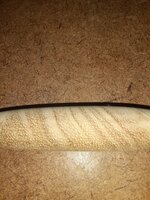Hey Penturners,
I'm attaching a picture of a piece of white limba that while in the middle of my sanding, noticed spots or maybe tiny craters. I started with 120 grit, then 150, 180, 220, 320. At that point, I stopped and noticed this issue. I sanded with the lathe at 645 rpms, and sanded with the grain when the lathe was turned off. I used new sand paper. I had this similar issue with a piece of tiger wood I just worked on also. Any suggestions would be greatly appreciated.
I'm attaching a picture of a piece of white limba that while in the middle of my sanding, noticed spots or maybe tiny craters. I started with 120 grit, then 150, 180, 220, 320. At that point, I stopped and noticed this issue. I sanded with the lathe at 645 rpms, and sanded with the grain when the lathe was turned off. I used new sand paper. I had this similar issue with a piece of tiger wood I just worked on also. Any suggestions would be greatly appreciated.

